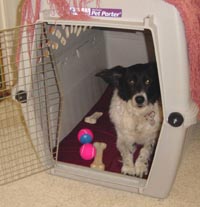|
Need Help? |
|
Call
1-800-372-3706
to
speak to a Veterinary Behavior Technician |
|
Paws for Help!
|
|

Click on Library Icon |
|
Help is at your
fingertips
by
library, email
and phone! |

Helpful Links
È
Close Tethering

Click on images
to purchase
 |
|
Dog Behavior Library
|
Pet Perception Management by
Rolan Tripp, DVM

Portable
Kennel (Crate) Training A Dog
What
is it?
The
goal of kennel training is that
a dog will willingly go into
the crate or any other enclosure
(e.g. cage at the veterinary
office) for any reasonable period
of time. A properly kennel trained
dog will perceive the crate
as his "den" or
"bedroom", and will
often spend time inside when
bored.
|
Since
dogs are den animals by
instinct, kennels create a "Safe
Place" for the dog. The crate should not be
used as a punishment, and
should be introduced to
the dog as young as possible. |
  Crate
training is an excellent thing
to do for any dog. Since dogs
are den animals by instinct,
it creates a "Safe Place"
for the dog. The crate should
not be used as a punishment,
and should be introduced to
the dog as young as possible. Crate
training is an excellent thing
to do for any dog. Since dogs
are den animals by instinct,
it creates a "Safe Place"
for the dog. The crate should
not be used as a punishment,
and should be introduced to
the dog as young as possible.
Size
matters
 When
purchasing a crate, choose one
just large enough for the dog
to stand, turn around and lie
down, as an adult. If
too large at first, place a box
in the back. If there is any
chance you will be air shipping
the dog, choose a molded plastic
"airline approved" crate. If it
is more likely you will car
travel with the dog, choose a
collapsible "Wire" crate. If you
use the wire type, it is best to
drape a blanket or towel over
the crate to give the dog the
sense of being in an enclosed
den. If it is left open, the dog
senses that others can see him,
but he cannot escape. When
purchasing a crate, choose one
just large enough for the dog
to stand, turn around and lie
down, as an adult. If
too large at first, place a box
in the back. If there is any
chance you will be air shipping
the dog, choose a molded plastic
"airline approved" crate. If it
is more likely you will car
travel with the dog, choose a
collapsible "Wire" crate. If you
use the wire type, it is best to
drape a blanket or towel over
the crate to give the dog the
sense of being in an enclosed
den. If it is left open, the dog
senses that others can see him,
but he cannot escape.
Ten steps
to crate training
- When
you bring home the crate,
act very interested
in it
and
put your arms inside.
-
Put a comfortable
bed
inside
the crate. The crate should be
the most comfortable place
the pet is allowed
rest.
Leave the door always open
at first, and if
needed,
remove the top half to be
open some
of the time.
-
Feed the dog in
the crate every meal.The goal
is for the dog to go into
the crate without hesitation.
Toss
kibbles and say, "Kennel!"
to mean "go inside."
-
Ignore the dog
more so
you can give attention for
being inside (until crate trained)
-
Hide treats or favorite toys
inside the crate.
Close the door
during meals.
-
Praise and give a food treat
for entering the crate. Ignore
him when exiting.
-
Overnight is the first time
to lock him in for hours.
If the
dog is too unsettled in the
crate, try moving the crate next
to your bed at night.
- If
he whines
at night, take him to his
elimination area
but be "robotic" with no
attention.
He needs
to learn not to wake you up
for attention
only.
-
If he continues to whine and
you know he doesn't need to
eliminate, try saying,
"QUIET".
If he doesn't stop on a
voice tone, then rap on the crate to startle
him. Gently praise
silence (GOOD QUIET). Gradually
increase the interval between
praising if quiet. (10 seconds,
20, 30, 1 minute, etc.)
-
No trespassing of children
allowed inside the crate.
(A dog can get away from children
in his safe place, including
no teasing or pestering while
crated)
When accidents
happen
 If
he messes in the crate, don't
punish, just clean it up and
re-evaluate the feeding and
confinement schedule.
You may need
to take the dog out more often.
Consider
removing food and water earlier
in the evening, and take
the dog out
later before bed. If
he messes in the crate, don't
punish, just clean it up and
re-evaluate the feeding and
confinement schedule.
You may need
to take the dog out more often.
Consider
removing food and water earlier
in the evening, and take
the dog out
later before bed.
A
crate alternative
 A
tool related to the crate is
the tether. This is
a 3 ft lead used to tie the
dog to a solid object IN YOUR
PRESENCE (e.g. while reading
or watching TV). The idea is
to bond the dog to you, confine
movement to prevent housesoiling,
and get the dog used to the
useful notion of being tied.
This technique is called, "Close
Tethering." A
tool related to the crate is
the tether. This is
a 3 ft lead used to tie the
dog to a solid object IN YOUR
PRESENCE (e.g. while reading
or watching TV). The idea is
to bond the dog to you, confine
movement to prevent housesoiling,
and get the dog used to the
useful notion of being tied.
This technique is called, "Close
Tethering."
|
|
|